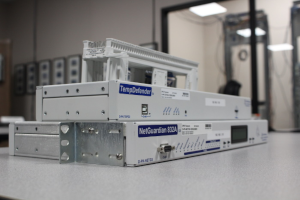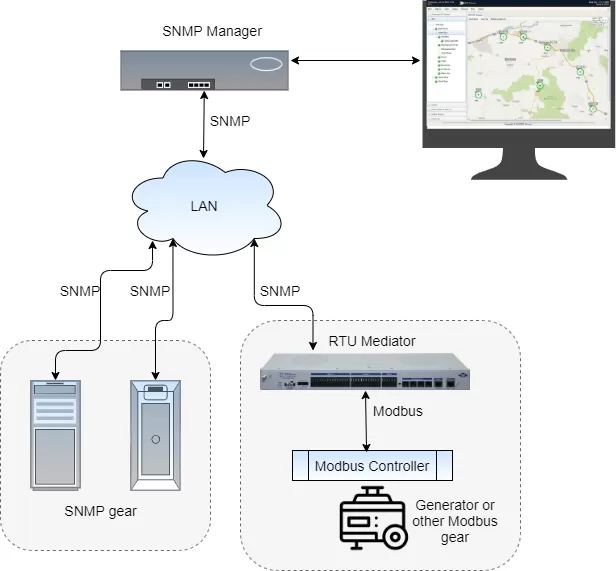Check out our White Paper Series!
A complete library of helpful advice and survival guides for every aspect of system monitoring and control.
1-800-693-0351
Have a specific question? Ask our team of expert engineers and get a specific answer!
Sign up for the next DPS Factory Training!

Whether you're new to our equipment or you've used it for years, DPS factory training is the best way to get more from your monitoring.
Reserve Your Seat TodayAnytime you're juggling a mix of industrial controls and IT gear, you face a real challenge. You might be questioning how to monitor Modbus TCP devices and SNMP-enabled equipment in a single pane of glass. This dilemma is shared by utilities, telecoms, transportation companies, and manufacturing plants around the globe.
Here, you'll discover why traditional fixes to Modbus-and-SNMP integration won't cut it, how a real solution should look, and how you can unify your entire network monitoring with a single approach. Let's get started!

At first glance, Modbus TCP and SNMP seem like they should be compatible. Both use network connections, both pass data among devices, and both were created to help you manage critical systems.
There's a key difference in how each operates, though:
If you try to monitor Modbus TCP devices directly from your SNMP manager, you'll quickly realize the protocols aren't the same "language." You're then left with two undesirable options:
Neither option is sustainable. As your network expands, so will your headaches.
Before a better solution existed, many companies tried to piece things together with partial fixes.
Some companies recorded Modbus and SNMP data into spreadsheets or emailed periodic reports to a single recipient, but this isn't a clean way to do things - and creates delays.
Others have tried deploying two systems: a SCADA for Modbus and an SNMP manager for network gear. The problem with this approach is critical alarms fall through the cracks. With separate systems, no one can effectively monitor all alarms.
A handful of teams built DIY middleware to poll Modbus devices and generate SNMP traps. The issue with this is it's time-consuming, difficult to scale, and dangerously dependent on a single developer. At DPS, we call this the "In-House Solution Stack Hack" problem. Yes, it happens so often that we have a name for it.
Ideally, you'll have one monitoring platform for everything - IT gear, industrial sensors, backup generators, and more. With this system, you'll have:
This is exactly what you can achieve when you convert Modbus data to SNMP with a rugged, proven RTU.
DPS Telecom's NetGuardian RTU family is designed from the ground up for this exact purpose.
Think of the NetGuardian as a bilingual translator. It speaks Modbus to your industrial equipment and immediately translates everything into fluent SNMP for your NOC. You won't need separate software or makeshift code some "genius" on your team wrote at some point. Your system will just work.
When you hook up your Modbus TCP devices to a NetGuardian RTU, you'll see simplicity on the surface. At the same time, there's a lot of intelligent work going on under the hood:
Using NetGuardians, you get real-time visibility into every piece of data your Modbus devices generate - without any manual logging or custom bridging software. With the right RTUs, issues are spotted early before they spiral into major outages.
Many older systems still rely on SNMPv1 or SNMPv2c. While they work, they're still inherently insecure:
If you're monitoring critical infrastructure - like backup power generators, PLCs, or environmental controls - SNMPv3 encryption is non-negotiable. You can't risk exposing alarm data to potential attackers, nor can you jeopardize compliance with cybersecurity mandates.
Because the NetGuardian supports SNMPv3, you can deploy it even in highly regulated sectors (utilities, public safety, government). This way, you get peace of mind that your system meets modern security demands - now and into the (foreseeable) future.
One of the easiest mistakes to make is buying a protocol translator that meets this year's needs but won't scale as your network evolves. The NetGuardian platform is designed to adapt and grow with you:
Choose a platform that won't force you into forklift upgrades down the road. With a NetGuardian RTU, you'll be covered long-term - even if you introduce new devices, new protocols, or new sites.
Jumping into protocol conversion without a plan can cause plenty of headaches. Before you start, be sure to ask yourself:
Once you answer these questions, you'll have a clear roadmap for your deployment. You'll also give DPS Telecom's engineers exactly what they need to propose the perfect solution. By planning now, you'll avoid unforeseen costs, ensure a smooth rollout, and end up with a monitoring platform that works for you.
Bridging Modbus TCP devices into your SNMP-based management system can be quite simple when you have the right hardware and planning. By relying on DPS Telecom's NetGuardian RTU (in one of several available capacity options), you'll get:
With the right approach, you can achieve unified monitoring - improving uptime, reducing costs, and gaining the peace of mind that you're in control of your entire network.
No one wants to keep suffering with disjointed systems, manual logs, or single-developer custom solutions. Thankfully, you can unify your entire monitoring strategy - without ripping and replacing existing gear.
Contact DPS Telecom today to speak with a protocol-integration expert. We'll help you design a solution tailored to your exact needs, whether you're monitoring four devices or four hundred or four thousand.
Let's get your Modbus TCP and SNMP gear working together!

Andrew Erickson
Andrew Erickson is an Application Engineer at DPS Telecom, a manufacturer of semi-custom remote alarm monitoring systems based in Fresno, California. Andrew brings more than 18 years of experience building site monitoring solutions, developing intuitive user interfaces and documentation, and opt...